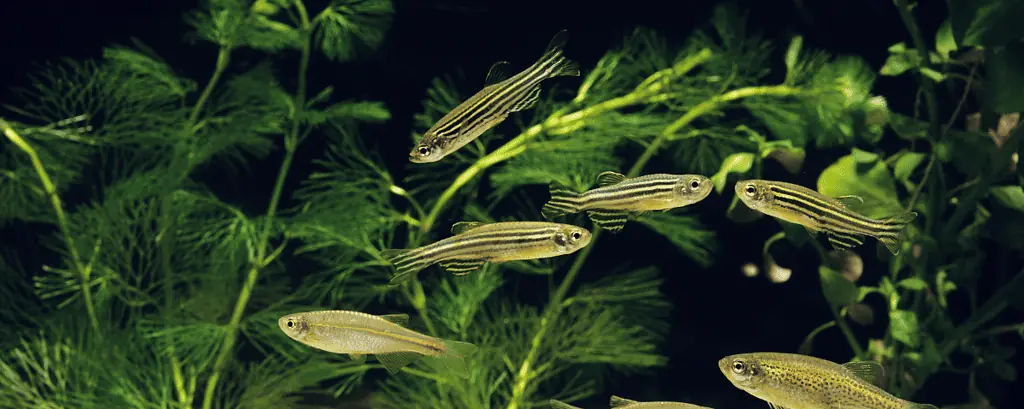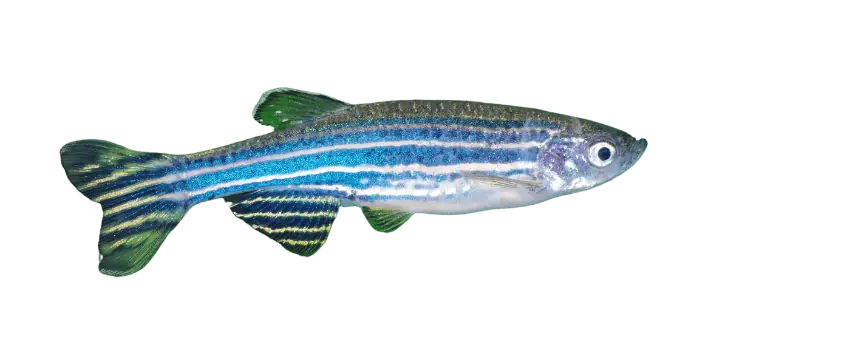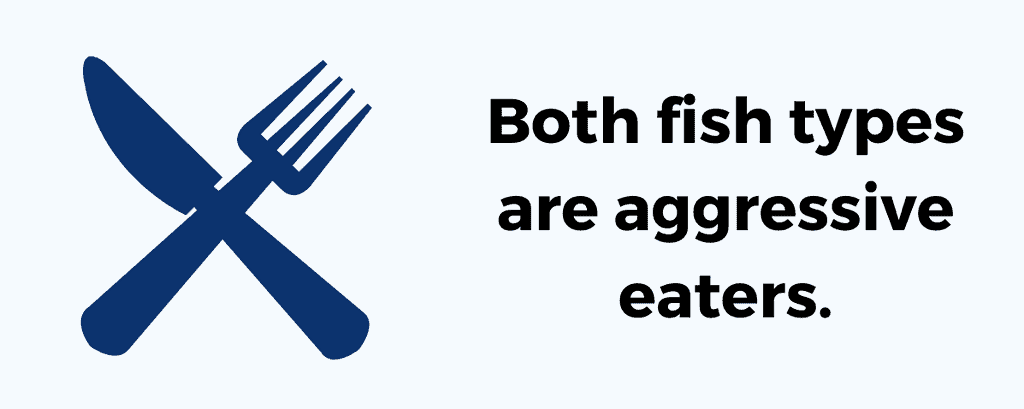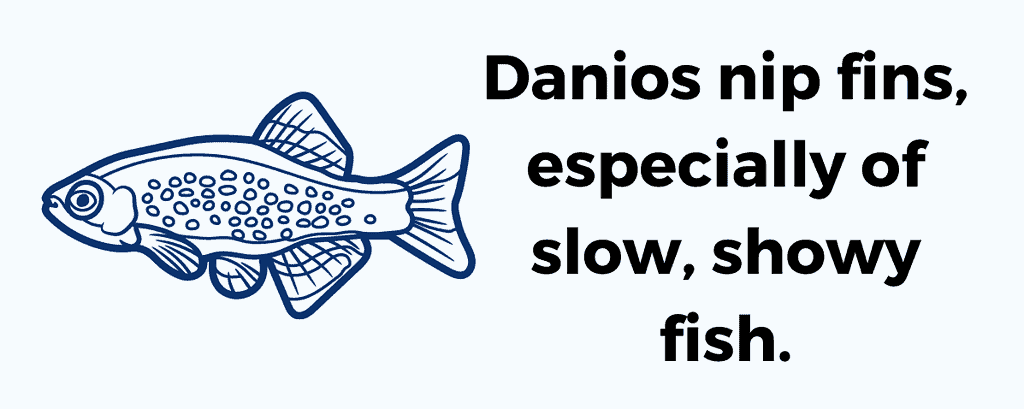Many people enjoy companion fish for their bettas. Bettas are full of personality and curiosity and need some company or they get bored.
Buying your betta a buddy will help. It is essential to choose fit companions for your betta regarding water parameters, tank setup, and behavior.
Zebra Danios are active schooling fish and are fun to watch dart around the tank. But are they good community tank mates for a betta?
Bettas and Danios do not make good tank mates because they require different water temperatures and behave incompatibly. Bettas are aggressive and danios will nip at a betta’s fins. Danios are schooling fish and require a larger tank (20 gallons minimum) with a more open swimming area than a betta.

Table of Contents
Danios And Bettas: Appearance & Personality

Betta Fish
The average betta is 3″ inches. Bettas are colorful, beautiful fish with long, flowing fins.
The natural habitat of bettas is still or slow-moving water in parts of Africa, Asia, and Australasia with plenty of vegetation.
Bettas are aggressive and territorial fish and will even attempt to fight through the glass of an aquarium.
Danios
Danios are usually silvery and slender, with vertical bars, rows of spots, or stripes like Zebra Danios. They are 1.5-2″ inches on average but can grow up to 3″ inches in rare cases.
The natural habitat of Danios across South Asia. They live in lowland streams and rivers, wetlands, and paddy fields with open swimming areas.
Danios are fairly peaceful fish and get along with most other fish. They are active, agile fish and nip the fins of fish like bettas or fancy guppies, or angel fish.
Bettas And Danios Care Needs

Tropical Water Conditions
Bettas need tropical temperatures between 78-80° degrees Fahrenheit (25.5-27° C), but Danios do not. Danios prefer cooler temperatures of 64-77° degrees Fahrenheit (17.7-25° C).
Besides this conflict in temperature requirements, bettas and danios require similar water parameters. Both prefer a pH of 6.5-7.5, 0 ppm of Ammonia and Nitrite, and less than 40 ppm of Nitrate.
Frequent water changes are part of keeping a betta healthy, as they are sensitive to bad water quality. They need a high-quality filtration system and partial weekly water changes of up to 20%.
Make sure you have an excellent aquarium water testing kit and check water quality frequently. Poor water conditions can lead to parasitic, bacterial, or fungal diseases for either fish.
Betta and Danio’s Habitat

In the wild, bettas live in slow-moving or still-fresh water with heavy vegetation. Think of bodies of water like ponds, rice paddies, and slow-moving streams.
Danios come from cooler water conditions and need more open swimming space. They are some of the hardiest fish around but still need a habitat close to how they live in nature.
Your betta habitat in your tank needs a good bit of natural planting to provide hiding and resting spots. Pieces of driftwood, roots, and rocks make natural barriers to create territories for your fish.
Fish being able to find shelter and get out of each other’s line of sight is crucial to minimizing aggression. A community fish tank needs to be set up with this in mind.
Avoid artificial plants or decor with sharp edges, flaking paint, or rust. Bettas like to rest on broad plant leaves, and sharp edges could injure them and lead to infection.
What They Like to Eat

Both danios and bettas will eat a similar diet of:
- Dried flake food
- Dried fish pellets
- Frozen fish foods
- Bloodworms
- Mosquito larvae
- Daphnia
But bettas should eat betta pellets or flakes as they are nutritionally designed for them.
Danios should not have tropical flake food too often, which can cause bloating and constipation.
Both danios and betta fish are aggressive eaters, which can cause feeding problems. Danios and bettas do not need feeding more than once or twice daily.
Can Danios Ever Live with Bettas?

Even though danios need cooler conditions than betta’s warm temperatures, some people have successfully kept danios with their bettas.
If you must attempt it, have a female betta live with your danios in at least a 20-gallon tank.
As with any community of fish, ensure all are fed enough to prevent fighting over food. Both Danios and bettas are food-aggressive.
Make sure you have lots of plants in your tank. This provides shelter for all the fish. They can hide from each other.
Quick swimmers, danios will nip the fins of your poor betta. They nip the fins of other fish, especially those fish with long flowing fins and who move more slowly, such as bettas.
This makes Danios a poor choice of tank mate for slow, showy fish.
Bettas are usually the only ones of their kind in a tank, as they are solitary fish. Danios require 5-6 or more to make a school.
Danio’s swimming behavior involves chasing one another and playing in the water current. This behavior threatens bettas, as they are territorial fish and are not such active swimmers.
Bettas swim in the upper part of the water column, close to the surface, where zebra danios also like to swim.
If your danios and bettas are incompatible, separating them is important before they hurt or kill each other.
All in all, danios are a stressful fish for a betta. As a rule of thumb, it is better not to keep them together.
What Are Danios Best Tank Mates?
Most docile community fish species are good companions for Danios. Here are some popular fish to pair with Danios:
- Ember tetras
- Swordtails
- Corydoras catfish
- Kuli loaches
Danios are active fish, and this active nature must be considered when choosing an ideal tank mate. While Danios may posture, they are not likely to fight.
Danios must be kept with fish of similar temperament who can hold their own but aren’t aggressive. If your fish have non-compatible temperaments, they will stress each other out or fight.
Make sure your danios do not have to compete for their food. Danios occasionally eat worm-based food, crustaceans, algae, shrimp pellets, and tropical flakes.
Danios should be slightly bigger or the same size as the other fish in the tank. There has to be enough room for everyone.
Remember also to choose the appropriate tank size.
The rule of thumb for choosing tank size is 1″ inch of fish per gallon of water to swim in.
So a school of 6 danios could eventually need 18 gallons, as they grow up to 3″ inches, although this length is rare.
Which Fish Can Live with Bettas?
Again, peaceful fish without flowy colorful fins are better tank mates for betta fish as bettas are aggressive fish.
Here is a list of fish that are good to live with your betta:
- Ember Tetras
- Rummy Nose Tetras
- Cardinal Tetras
- Neon Tetras
- Black Neon Tetras
- Guppies (Females only)
- Platys
- Harlequin Rasboras
- Lambchop Rasboras
- Dwarf Rasboras
- Scissortail Rasboras
- Chili/Mosquito Rasbora
- Bronze (Common) Corys
- Endlers Livebearers
- Dwarf Loach
- Mollies
- Otocinclus Catfish
- Glass Catfish
Male bettas do not live peacefully with other bettas. They will fight and injure each other, often to the death.
Female bettas can live with other female bettas. This grouping of 4 to 6 fish is called a sorority or sometimes a harem.
Also, you do not want your betta to compete with other fish for its food. This will lead to fighting, injury, and even death.
Remember to choose the best tank size for your betta’s happy living – at least 5 gallons for a sole betta fish. Betta fish compatibility depends on temperament and habitat requirements.
What Fish Cannot Be with Bettas?
Betta fish are aggressive towards fish who look like themselves: bright and colorful with flowing fins. Bettas will attack other fish on the scales, gills, and tails.
Aggressive fin nippers, such as angelfish, or red-tail sharks, are not good breeds of fish to keep with bettas. Fish larger than the betta and goldfish also do not make good tank mates.
Danios & Bettas: Not The Best Of Friends
The need for a slightly cooler tank and more fish to socialize with make the Danio a poor choice of tank mate for our betta friends.
It’s possible to make it happen, but unless you’re in love with both species and have experience with fish, it’s best to look for another option.
For more on which fish species and other creatures make suitable companions for bettas, check out our article on the best (and worst) betta tank mates.


